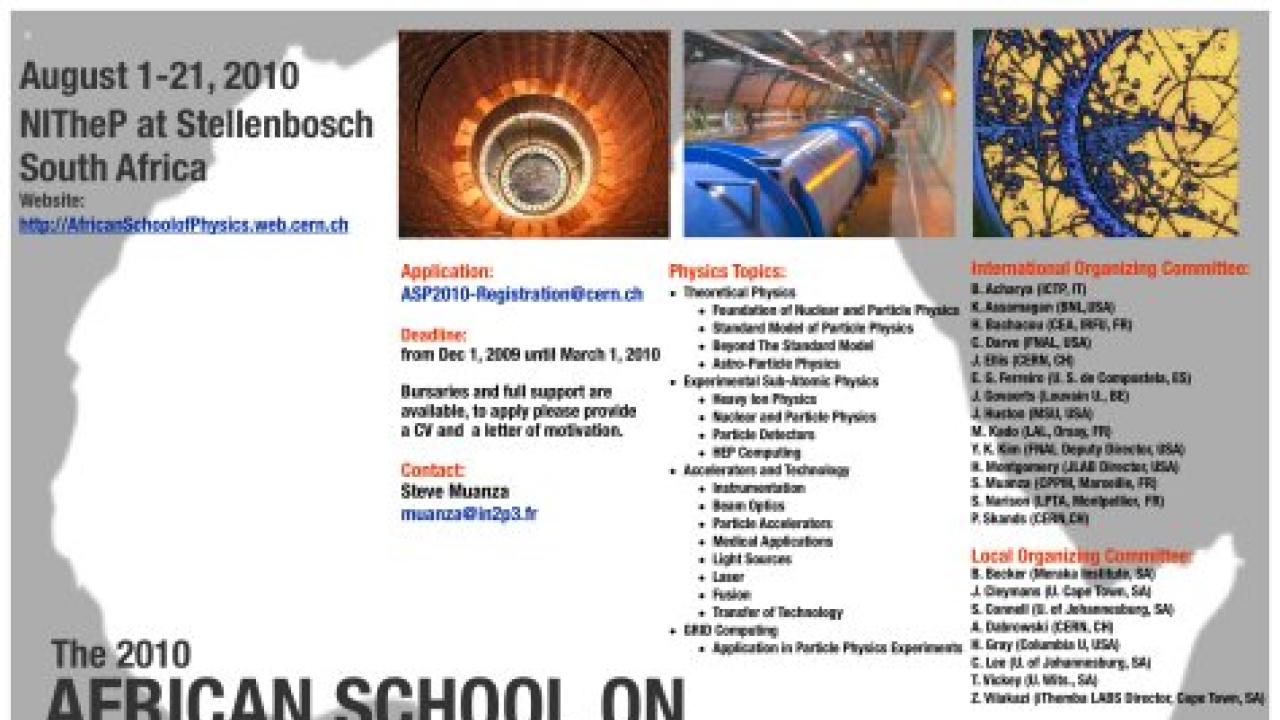
This August, students and scientists from African countries will get the
rare opportunity to learn about innovative physics experiments,
accelerators and technology on their own continent.
The first African School of Physics will take place 1-21 August at the
National Institute of Theoretical Physics in Stellenbosch, South Africa.
ICTP, along with 12 other international institutions, is supporting the
School.
Fifty-nine students—including 40 from 17 African countries—will take
part in the programme, learning about theoretical and experimental
physics from leading international scientists. Most of the students are
pursuing or have completed advanced degrees in physics, but lack
opportunities to gain specialized knowledge in subatomic physics. The
trip and expenses for all African students are paid for by the school.
"This may be the first opportunity these students have to learn about
particle and nuclear physics," said Steve Muanza, a physicist at
France’s CNRS/IN2P3 and the co-founder and director of the school. "We
hope that the material presented at the school piques their interest and
they go on to pursue these topics."
ICTP high energy physicist Bobby Acharya, one of the school's
organizers, said that the school represents an international effort to
build scientific capacity in sub-Saharan Africa. "That area of the
continent needs the most assistance in developing capacity in particle
and nuclear physics. There are few high energy physics experts and
researchers there, and very little experimental efforts, except in South
Africa, which is why we decided to locate the first school there," he
explained.
Topics to be covered include current and future particle and nuclear
physics experiments, theoretical physics, particle accelerators and
technology, information technology and grid computing. Simon Connell, a
member of the local organizing committee, believes that the intensive
three-week program could equate to a semester-long university course.
"We will cover a lot of subject matter not taught at any university in
Africa," Connell said. "Students can take the knowledge they learn here
back to their home institutions, where they can continue researching and
teaching. We don't expect the benefits of the school to stop when they
leave."
Acharya stated that the students' newly-gained knowledge will be
sustained by a mentoring programme that will pair them with the School's
lecturers. He also hopes that some of the students will consider
continuing their studies at ICTP, through its Diploma Programme in High
Energy or Basic Physics or by attending the Centre's many workshops and
schools.
Students won’t be limited to lecture halls. A videoconference with the
CERN particle physics laboratory in Geneva, Switzerland, will link
students with physicists operating the Large Hadron Collider from CERN’s
Control Centre for accelerators. Students will also spend one afternoon
at iThemba LABS, an accelerator facility in South Africa, practicing
laboratory experiments and learning about how particle physics and its
associated technologies can apply to other fields, including medicine.
“The lessons in these final days of the school will help students link
the concepts they've learned to the real world," said Fermilab scientist
Christine Darve, head school organizer.
This year’s school takes place in South Africa, the first African
country to become a member of an experiment at CERN’s Large Hadron
Collider. Organizers hope this will be the start of a tradition, and
plan to host the school every two years.
The school is administered and supported by the following institutes:
Abdus Salam International Centre for Theoretical Physics (ICTP),
Trieste, Italy; Brookhaven National Laboratory, New York, USA;
Commissariat a l’énergie atomique (CEA), France; Ecole Polytechnique
Federale de Lausanne (EPFL), Lausanne, Switzerland; European
Organization for Nuclear Research (CERN), Geneva, Switzerland; Fermi
National Accelerator Laboratory (Fermilab), Illinois, USA; Centre
National de la Recherche Scientifique (CNRS), Institut National de
Physique Nucléaire et de Physics des Particules (IN2P3), and Institut
des Grilles, France; National Institute for Theoretical Physics
(NITheP), Stellenbosch, South Africa; National Research Foundation
(NRF), South Africa; Spanish Agency for International Cooperation and
Development, Minister of Foreign Affairs (AECID), through the University
of Santiago de Compostela; Paul Scherrer Institute (PSI), Villigen,
Switzerland; Thomas Jefferson National Accelerator Facility and
Jefferson Science Associates, Virginia, USA.
For more information and photos, visit the first African School of Physics website.
















